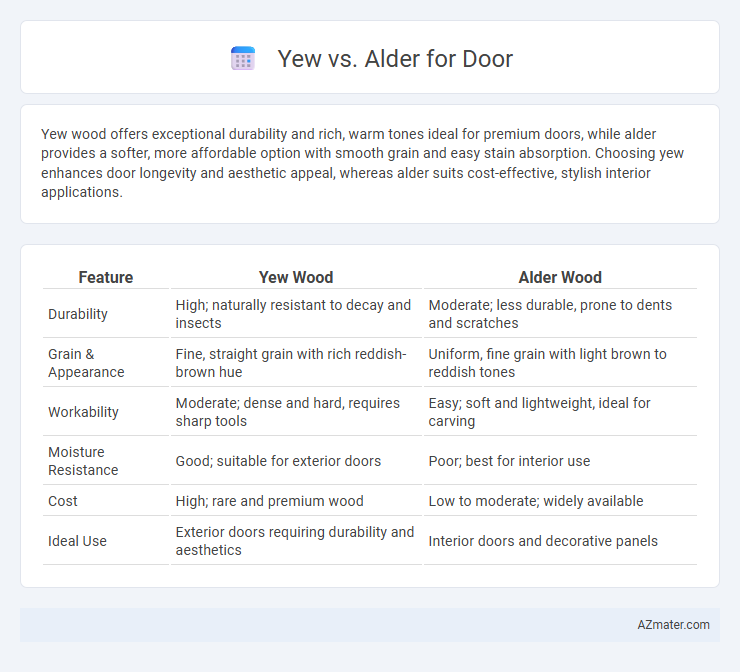Yew wood offers exceptional durability and rich, warm tones ideal for premium doors, while alder provides a softer, more affordable option with smooth grain and easy stain absorption. Choosing yew enhances door longevity and aesthetic appeal, whereas alder suits cost-effective, stylish interior applications.
Table of Comparison
| Feature | Yew Wood | Alder Wood |
|---|---|---|
| Durability | High; naturally resistant to decay and insects | Moderate; less durable, prone to dents and scratches |
| Grain & Appearance | Fine, straight grain with rich reddish-brown hue | Uniform, fine grain with light brown to reddish tones |
| Workability | Moderate; dense and hard, requires sharp tools | Easy; soft and lightweight, ideal for carving |
| Moisture Resistance | Good; suitable for exterior doors | Poor; best for interior use |
| Cost | High; rare and premium wood | Low to moderate; widely available |
| Ideal Use | Exterior doors requiring durability and aesthetics | Interior doors and decorative panels |
Introduction to Yew and Alder Wood
Yew wood, prized for its dense grain and rich reddish-brown hue, offers exceptional durability and resistance to decay, making it a preferred choice for high-quality doors that require longevity and aesthetic appeal. Alder wood, softer and lighter with a fine, uniform texture, provides a cost-effective alternative that is easy to work with, often chosen for its smooth finish and warm, pale color that suits various interior door designs. Both woods have distinct characteristics: yew excels in strength and weather resistance, while alder is favored for affordability and ease of customization.
Botanical Origins and Growth Patterns
Yew (Taxus baccata) is an evergreen conifer native to Europe, known for its slow growth and dense, dark green needles, making it prized for durable, fine-grained doors. Alder (Alnus glutinosa), a deciduous hardwood from temperate Europe and western Asia, exhibits rapid growth with a lighter, softer grain suitable for water-resistant and rustic door designs. Yew's longevity and tight grain contrast with alder's faster maturity and porous texture, crucial for selecting door materials based on botanical origin and growth characteristics.
Physical Appearance: Grain, Color, and Texture
Yew wood exhibits a fine, uniform grain with distinctive creamy-yellow sapwood contrasting against rich reddish-brown heartwood, creating a visually striking door surface. Alder offers a straight, even grain pattern with a consistent light brown to reddish-brown color, providing a warm and subtle aesthetic. The smooth texture of Yew contrasts with Alder's fine but slightly coarser texture, influencing the tactile feel and finish quality of doors crafted from these woods.
Durability and Hardness Comparison
Yew wood exhibits superior durability and hardness compared to alder, making it a resilient choice for doors subject to heavy use and environmental stress. Yew's Janka hardness rating typically ranges around 1,500 lbf, significantly higher than alder's 590-600 lbf, indicating better resistance to dents and wear. The natural oils in yew also enhance its longevity by providing intrinsic moisture resistance, while alder is more prone to dings and requires additional protective finishes.
Workability and Ease of Machining
Yew wood offers excellent workability with a fine, even texture that allows for smooth cutting and carving, making it highly suitable for intricate door designs. Alder is known for its consistent grain and softness, which facilitates easy machining and reduces the risk of splitting or chipping during shaping. Both woods perform well in joinery, but Alder's uniform density makes it particularly favored for precise, hassle-free fabrication in door manufacturing.
Resistance to Decay and Insects
Yew wood exhibits superior resistance to decay and insects compared to alder, making it a durable choice for doors exposed to moisture and pests. Alder, while moderately resistant, is more prone to fungal attacks and insect damage, reducing its longevity in harsh environments. Selecting yew for exterior doors ensures enhanced durability and reduced maintenance due to its natural preservative qualities.
Cost and Availability in the Market
Yew wood is generally more expensive than alder due to its slower growth rate and limited availability, making it a premium choice for doors. Alder is widely available and more affordable, offering a cost-effective option without sacrificing durability or aesthetic appeal. Market availability of alder ensures quicker procurement, while yew may require longer lead times due to its rarity and higher demand among specialty woodworkers.
Finishing and Staining Qualities
Yew wood exhibits a fine, dense grain that takes stain evenly, resulting in a smooth, rich finish ideal for high-quality doors. Alder wood, being softer with a more open grain, absorbs stain unevenly but offers a warm, natural look when properly prepared and sealed. Both woods respond well to finishing, but Yew's natural oils promote durability and a longer-lasting stain compared to Alder.
Suitability for Exterior and Interior Doors
Yew wood offers exceptional durability, natural resistance to decay, and a rich grain, making it highly suitable for both exterior and interior doors that require longevity and aesthetic appeal. Alder wood, known for its workability and smooth finish, excels in interior door applications but is less ideal for exterior use due to its lower resistance to moisture and weather conditions. Choosing Yew for exterior doors ensures better protection against the elements, while Alder provides a cost-effective, attractive option for interior door designs.
Environmental Impact and Sustainability
Yew wood, known for its tight grain and natural resistance to decay, offers exceptional durability for doors while requiring slower growth periods, impacting its sustainability negatively compared to faster-growing Alder. Alder, a rapidly renewable hardwood, provides a more environmentally sustainable option due to its quicker regrowth and lower harvesting impact, making it ideal for eco-conscious door manufacturing. Both woods contribute to carbon sequestration, but Alder's faster growth cycle enhances carbon capture efficiency over time.

Infographic: Yew vs Alder for Door
 azmater.com
azmater.com